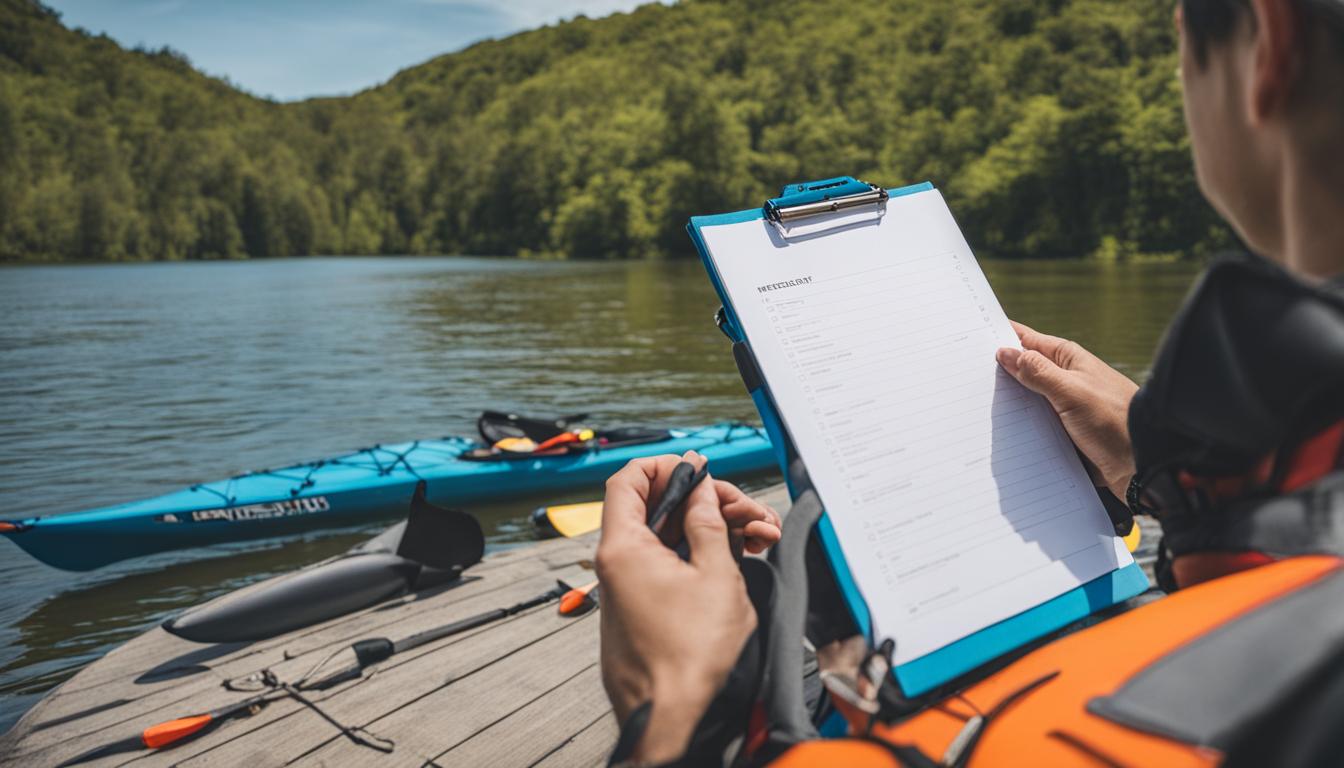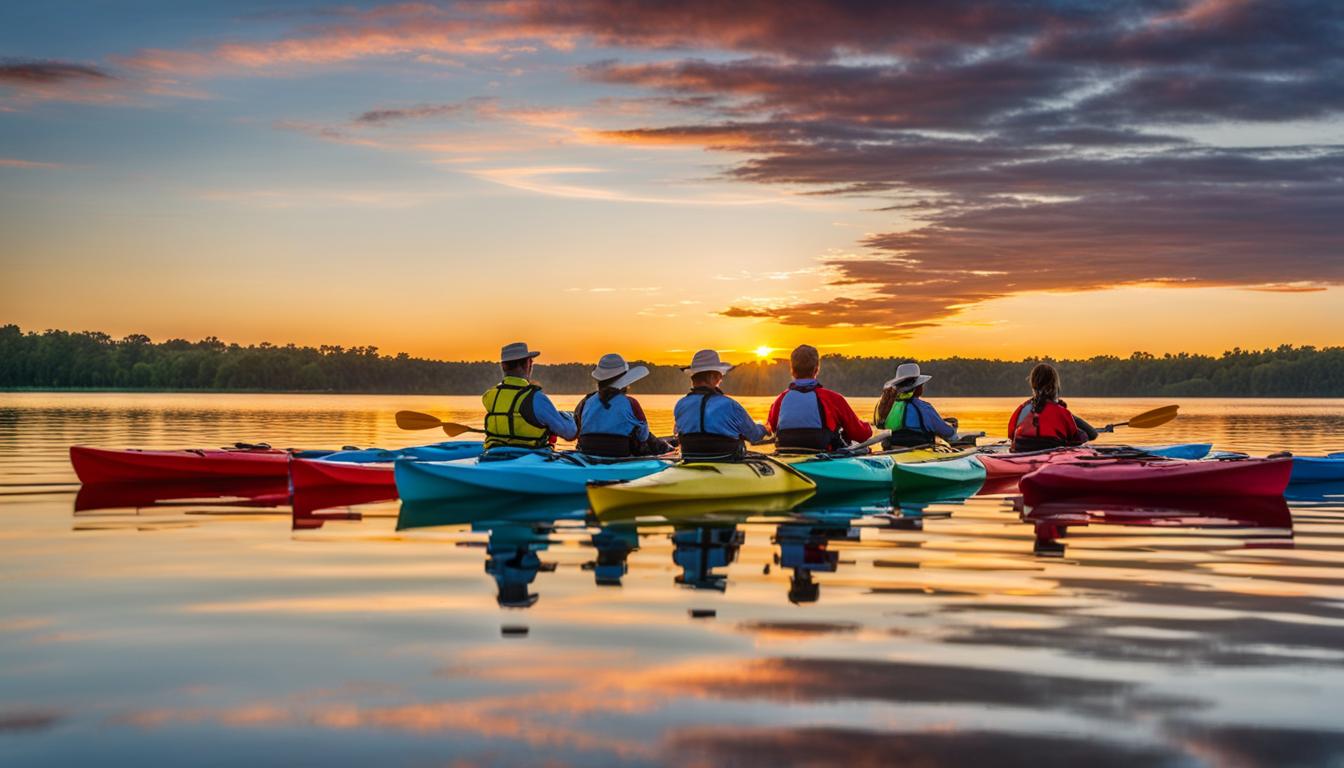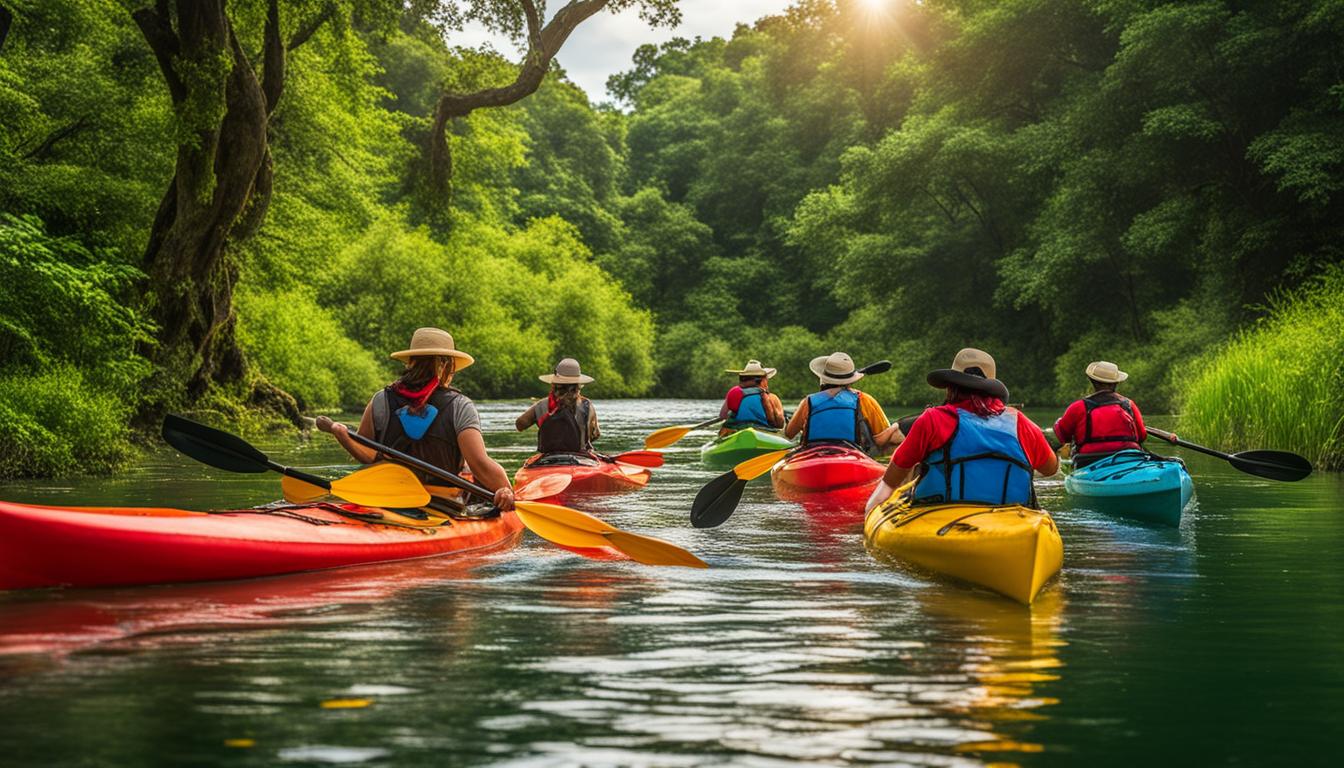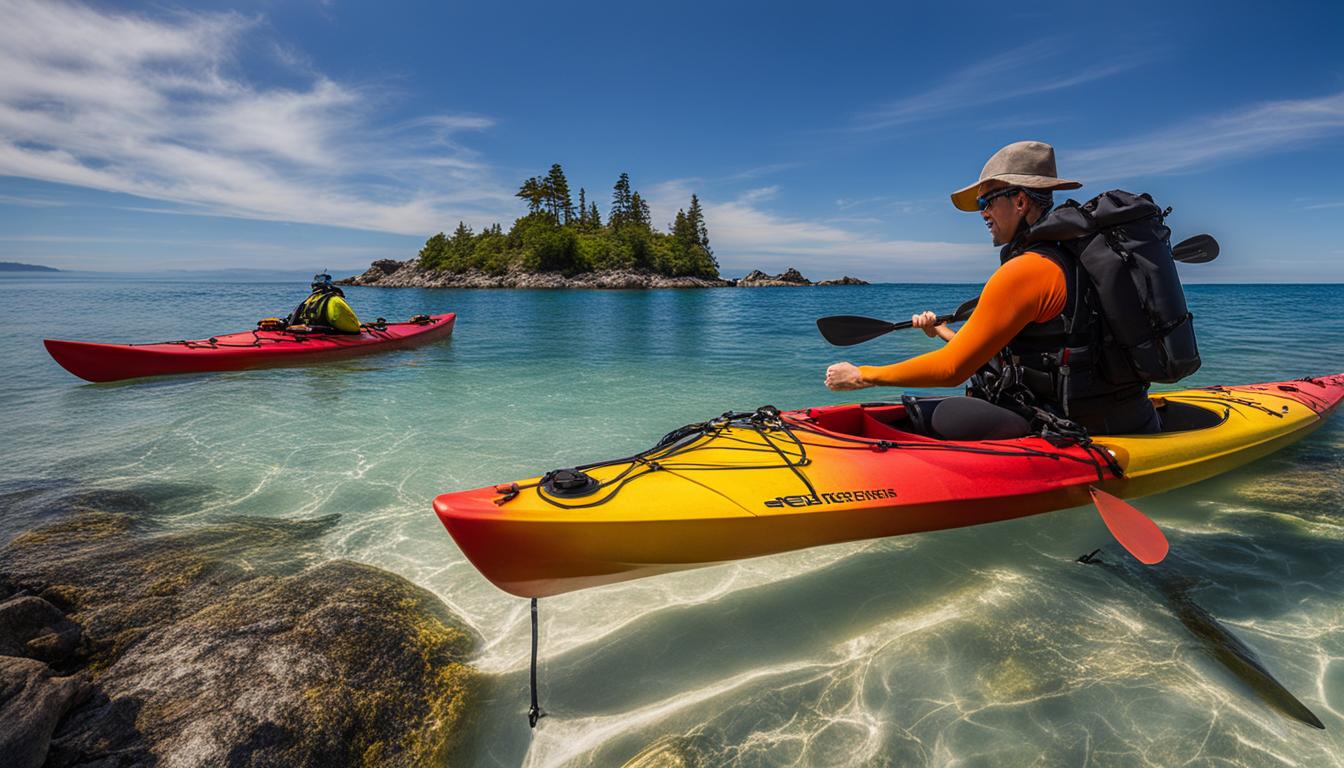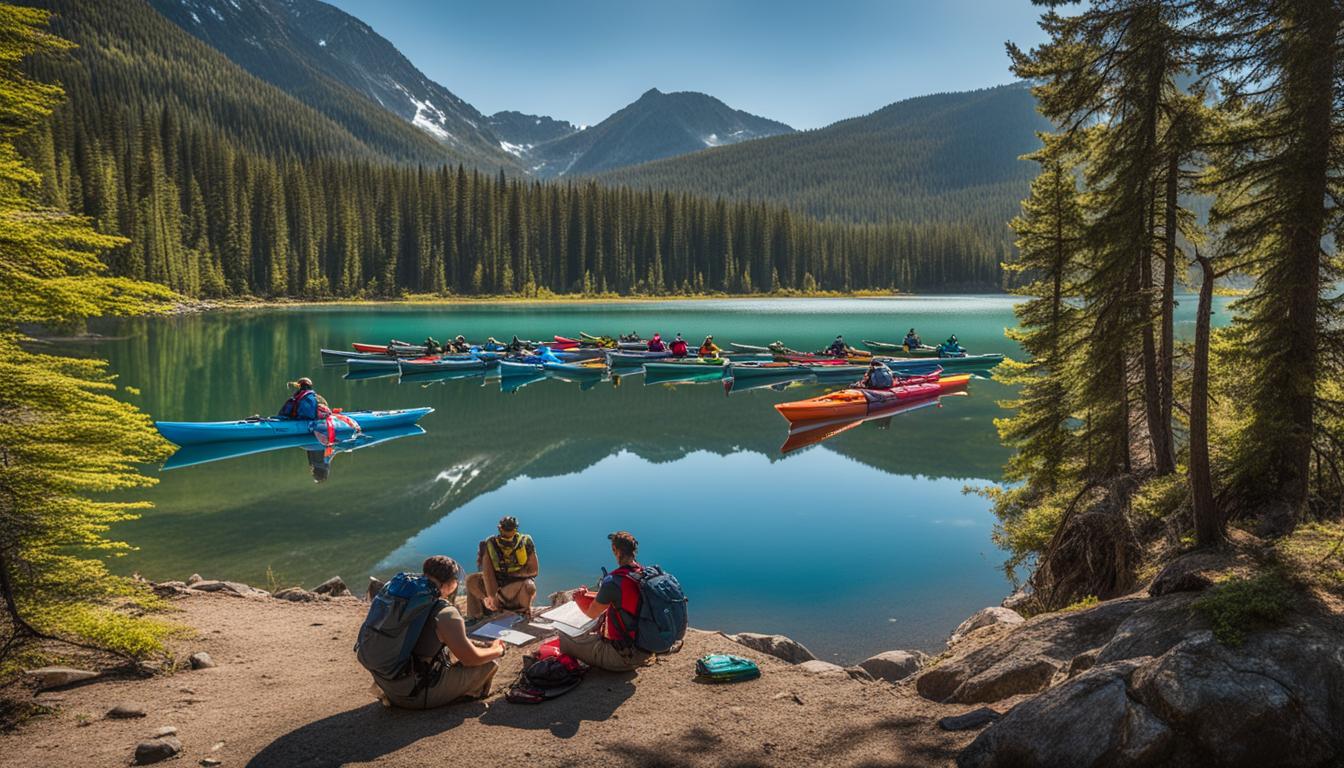Before renting a kayak, it is crucial to ask the right questions to ensure a safe and enjoyable experience. By gathering important information from kayak rental companies, you can make informed decisions that will enhance your time on the water. Here are some pre-rental kayak questions that you should consider:
Key Takeaways:
- Asking questions before renting a kayak helps ensure a safe and enjoyable experience.
- Important questions to ask include kayak style, solo or tandem preference, skeg or rudder options, and guided or self-guided paddling.
- It’s essential to prioritize safety and preparedness by checking the kayak’s condition and having the necessary safety equipment.
- Consider asking about kayak rental availability, restrictions, cancellation policies, and any special needs or insurance requirements.
- By asking these questions, you can make the most of your kayak rental experience and have a memorable outdoor adventure.
Choosing the Right Kayak
When renting a kayak, it’s essential to consider the specific style that will best suit your needs. There are different types of kayaks available, each with its own characteristics and suitability for various conditions and paddling styles.
One popular style is the recreational kayak. These kayaks are versatile and user-friendly, making them a great choice for beginners or those looking for a casual paddling experience. Recreational kayaks are typically shorter and wider, providing stability and ease of maneuverability in calm waters and mild currents.
For those seeking longer adventures and more advanced paddling experiences, touring kayaks are a suitable option. These kayaks are designed for efficiency and speed, allowing you to cover longer distances with less effort. They often have a longer and narrower shape, providing better tracking and stability in open water and rougher conditions.
Alternatively, if you prefer a kayak that allows for easy entry and exit or want to enjoy swimming or fishing during your paddling trip, a sit-on-top kayak may be the ideal choice. Sit-on-top kayaks are self-bailing and provide a more open and spacious cockpit, making them perfect for recreational activities and warm weather enjoyment.
Table: Comparison of Kayak Styles
| Kayak Style | Suitability | Characteristics |
|---|---|---|
| Recreational Kayak | Beginners, casual paddlers | Stability, maneuverability |
| Touring Kayak | Experienced paddlers, long-distance trips | Efficiency, speed, tracking |
| Sit-on-Top Kayak | Recreational activities, warm weather | Easy entry and exit, self-bailing |
By choosing the right kayak style, you can enhance your paddling experience and ensure that you have a kayak that meets your specific needs and preferences. Whether you opt for a recreational kayak, touring kayak, or sit-on-top kayak, there is a style available that will allow you to enjoy the beauty of the water while feeling comfortable and confident on your adventure.

“Choosing the right kayak style is crucial for an enjoyable and safe paddling experience.”
Solo or Tandem Kayak?
When renting a kayak, one of the important decisions you need to make is whether to paddle solo or tandem. Both options have their own benefits and considerations, so it’s essential to choose the one that aligns with your preferences and needs.
If you enjoy the freedom and independence of exploring at your own pace, solo kayaking may be the perfect choice for you. With a solo kayak, you have complete control over your journey and can easily navigate through different water conditions. It’s a great option for experienced kayakers who want to challenge themselves and explore new territories.
On the other hand, if you prefer to paddle with a partner or want to share the experience with a friend or family member, a tandem kayak is a fantastic option. Tandem kayaking allows you to enjoy the adventure together, fostering teamwork and creating lasting memories. It’s also an ideal choice for beginners who may feel more comfortable and supported paddling with a partner.
Consider your level of comfort, experience, and the type of experience you desire when deciding between solo and tandem kayaking. Remember, no matter which option you choose, the most important thing is to have a safe and enjoyable time on the water.
Taking the Plunge: Solo or Tandem?
The decision between solo and tandem kayaking ultimately comes down to personal preference and the specific experience you want to have on the water. To help you make an informed decision, here are some factors to consider:
- Independence vs. companionship: Do you enjoy the solitude and freedom of solo exploration, or do you prefer sharing the experience with someone?
- Experience level: Are you an experienced kayaker looking for a challenge, or are you a beginner seeking guidance and support?
- Physical ability: Consider the physical demands of kayaking and whether you feel more comfortable paddling on your own or sharing the workload with a partner.
- Destination and activity: Think about the type of kayaking you plan to do. Are you exploring calm lakes and rivers, or are you venturing into more challenging conditions?
Kayaking is a versatile and exciting activity that can be enjoyed in various ways. Whether you choose to paddle solo or tandem, remember to prioritize safety, have fun, and make lasting memories on the water.
The Benefits of Solo and Tandem Kayaking
| Solo Kayaking | Tandem Kayaking | |
|---|---|---|
| Independence | ✔️ | ❌ |
| Companionship | ❌ | ✔️ |
| Freedom to Explore | ✔️ | ❌ |
| Support and Teamwork | ❌ | ✔️ |
| Challenging Experience | ✔️ | ❌ |
| Easier Learning Curve | ❌ | ✔️ |
Understanding Skegs and Rudders
When considering renting a kayak, one important factor to consider is whether you want a kayak with a skeg or a rudder. Both of these features provide additional control and stability while paddling, but they serve different purposes.
A skeg is a retractable fin located on the kayak’s hull, usually towards the stern. It helps improve tracking, which is the ability of the kayak to maintain a straight course. By deploying the skeg, you can counteract the influence of wind and waves, ensuring better stability and control. Skegs are particularly useful in windy or choppy conditions where maintaining a steady course can be challenging.
A rudder, on the other hand, is a movable fin located at the kayak’s stern. It can be controlled by foot pedals and allows for enhanced maneuverability and steering. With a rudder, you can make precise turns and navigate narrow passages more easily. This feature is especially valuable when paddling in areas with strong currents or tight spaces.
When deciding between a kayak with a skeg or a rudder, consider your skill level and the conditions you will encounter. If you are a beginner or will be paddling in calm waters, a kayak with a skeg might be sufficient to provide the stability and control you need. However, if you plan to paddle in more challenging environments or desire greater maneuverability, a kayak with a rudder could be a better choice.
Table: Comparison of Skegs and Rudders in Kayaks
| Skeg | Rudder |
|---|---|
| Aids in tracking and stability | Enhances maneuverability and steering |
| Retractable fin | Movable fin controlled by foot pedals |
| Useful in windy or choppy conditions | Valuable in areas with strong currents or tight spaces |
| Provides stability for beginners | Enables precise turns and navigation |
Remember to communicate your preference for a kayak with a skeg or a rudder when renting, as not all kayaks will have these features. Discussing your needs and paddling environment with the rental company can help ensure you have the most suitable kayak for your adventure, allowing you to enjoy the water with confidence and control.
Guided or Self-Guided Paddling
Once you rent a kayak, you have the choice to embark on your paddling adventure in various ways. Whether you are a beginner or an experienced paddler, there are options available to suit your preferences. Let’s explore the different choices you have:
Taking a Lesson
If you are new to kayaking or would like to enhance your skills, taking a lesson is a great option. Lessons can provide valuable instruction on paddling techniques, safety measures, and navigating different water conditions. Learning from a certified instructor can boost your confidence and ensure a safe and enjoyable experience on the water.
Being Guided by an Expert
If you prefer a more immersive and educational experience, opting for a guided tour can be an excellent choice. Guided tours are led by knowledgeable experts who will take you to scenic locations and share interesting insights about the environment and wildlife. This option allows you to explore new areas without worrying about navigation, offering a stress-free and educational outing.
Paddling on Your Own
If you crave independence and the freedom to create your own adventure, paddling on your own is the way to go. Renting a kayak and exploring at your own pace allows you to fully immerse yourself in the serenity of nature and enjoy the tranquility of being on the water. However, it’s important to have some experience and knowledge of basic safety measures before venturing out solo.
Regardless of the option you choose, each offers its own unique experience. Consider your skill level, comfort, and desire for exploration when deciding whether to take a lesson, be guided by an expert, or paddle on your own. Remember to always prioritize safety and enjoy the journey!
Table: Comparison of Guided versus Self-Guided Paddling
| Guided Paddling | Self-Guided Paddling |
|---|---|
| Expert guidance and knowledge | Freedom to create your own adventure |
| Learning experience with valuable insights | Opportunity to explore at your own pace |
| Access to scenic locations | Immerse yourself in the serenity of nature |
| Safe and stress-free navigation | Opportunity for independence and self-reliance |
As you can see, guided paddling offers the advantages of expert guidance, learning experiences, and access to scenic locations. On the other hand, self-guided paddling provides the freedom to explore at your own pace and immerse yourself in the serenity of nature. Consider your preferences and goals for your kayaking experience to decide which option is best for you!
Ensuring Safety and Preparedness
Before heading out on your kayak rental adventure, it is crucial to prioritize safety and ensure you are adequately prepared. Taking the time to assess your readiness and make necessary preparations will help you have a safe and enjoyable experience on the water.
Assessing Your Preparedness
Ask yourself: How prepared am I to go kayaking? Consider your level of experience, physical fitness, and knowledge of kayaking techniques. If you are a beginner, it may be beneficial to take a kayaking lesson or seek guidance from a knowledgeable instructor. Furthermore, evaluate the weather conditions and water environment you will be paddling in. Familiarize yourself with potential hazards and any specific safety precautions that may apply.
Equipment Checklist
Staying safe on the water begins with ensuring that everything on your kayak is in working order. Before setting off, perform a thorough check of your equipment. Inspect the kayak for any damages or cracks that could compromise its integrity. Test the stability of the kayak and check that the seat and footrests are properly adjusted for your comfort. Additionally, ensure that all required safety equipment is on board, including a personal flotation device (PFD), a whistle or signaling device, and a bailer or bilge pump to remove excess water if necessary.
“Safety isn’t expensive, it’s priceless.” – Anonymous
Creating Your Float Plan
Another important aspect of preparedness is creating a float plan. A float plan is a document that outlines your trip details and is shared with a trusted person or authority. Include information such as your intended route, estimated time of departure and return, and contact information for emergency services. This plan will ensure that someone is aware of your whereabouts and can take action if you do not return as scheduled.
| Essential Safety Tips | Guidelines |
|---|---|
| Always wear your personal flotation device (PFD). | Ensure it fits properly and is securely fastened. |
| Stay alert and aware of your surroundings. | Watch out for other boats, obstacles, or changing weather conditions. |
| Stay hydrated and protect yourself from the sun. | Wear sunscreen, a hat, and sunglasses. |
| Practice proper paddling techniques. | Learn how to control and maneuver your kayak effectively. |
| Respect the environment and wildlife. | Do not disturb or harm the natural surroundings. |
By taking the time to assess your preparedness, ensuring the functionality of your equipment, and creating a float plan, you can enjoy a safe and worry-free kayaking experience. Remember, staying safe on the water is essential for a memorable adventure.
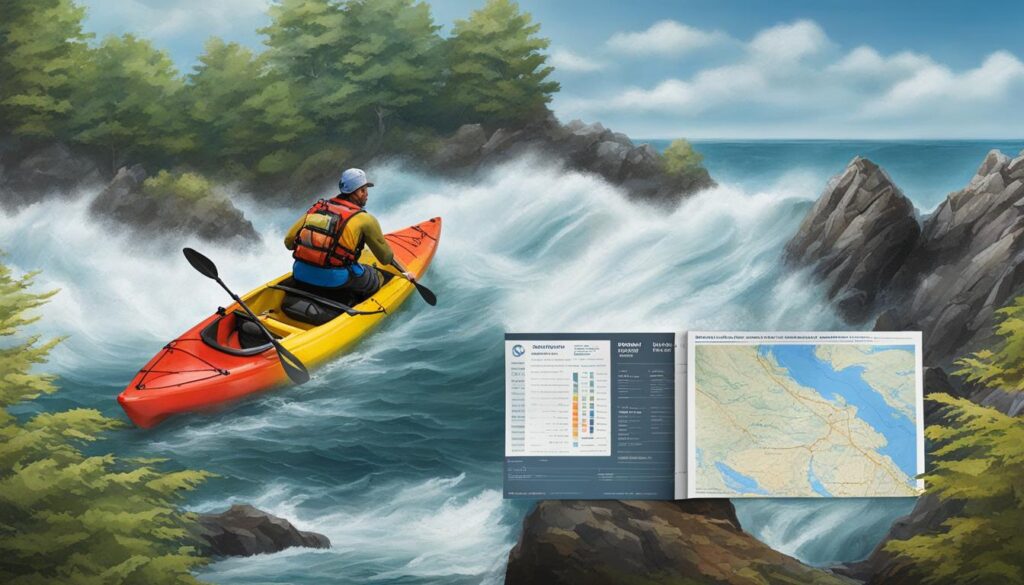
Conclusion
Planning to rent a kayak for your next adventure? Keep these essential questions in mind to ensure a safe and enjoyable experience. By asking about kayak rental safety inquiries, inquiring about kayak tour routes, and questioning the kayak rental gear, you can make informed decisions and have a memorable time on the water.
Don’t forget to ask about kayak insurance to protect yourself and your belongings. Additionally, inquire about the kayak rental duration and availability to plan your excursion accordingly. Some rental companies may have restrictions or special requirements, so be sure to ask about any limitations or specific needs you may have.
Lastly, it’s crucial to inquire about the kayak rental cancellation policies. It’s always good to know the guidelines in case your plans change unexpectedly. By considering these factors and asking the right questions, you can ensure a smooth and hassle-free kayak rental experience.
FAQ
What are some essential questions to ask before renting a kayak?
Before renting a kayak, it is important to ask about kayak rental safety, inquire about kayak tour routes, ask about kayak rental gear, find out about kayak insurance options, ask about the duration of the rental, check kayak rental availability, inquire about any kayak rental restrictions, ask about any special needs you may have, and find out about the kayak rental cancellation policies.
What style of kayak should I rent?
When choosing a kayak, consider the specific style that will best suit your needs. There are different types available, such as recreational kayaks, touring kayaks, and sit-on-top kayaks. Each has its own characteristics and is suitable for different conditions and paddling styles.
Do I want to kayak solo or tandem?
Decide whether you want to paddle solo or with a partner in a tandem kayak. Solo kayaks offer independence and freedom, while tandem kayaks are ideal for beginners or those who prefer to paddle with a companion. Consider your comfort level and experience when making this decision.
Do I want a kayak with a skeg or a rudder?
Some kayaks come with a skeg or a rudder. A skeg aids in tracking and controlling the influence of waves and wind on the kayak. A rudder allows for better direction control. Consider your skill level and the conditions you will be paddling in when choosing between a kayak with a skeg or a rudder.
Once I rent a kayak, will I take a lesson, be guided, or paddle by myself?
When renting a kayak, you have the option to take a lesson, be guided by an expert, or paddle on your own. Lessons can be valuable for both beginners and experienced paddlers. Guided tours offer the opportunity to explore new areas and learn from knowledgeable guides. Paddling on your own allows for independence and freedom to create your own adventure.
How prepared am I to go kayaking?
Before heading out on your kayak rental, it is important to prioritize safety and ensure you are adequately prepared. This includes creating a float plan, having essential safety equipment, being familiar with the area’s water conditions, and checking the kayak for any damages or malfunctions.
What else should I inquire about when renting a kayak?
In addition to the above questions, you may want to inquire about kayak rental safety, tour routes, gear, insurance options, duration, availability, restrictions, special needs, and cancellation policies to make the most of your kayak rental experience.

